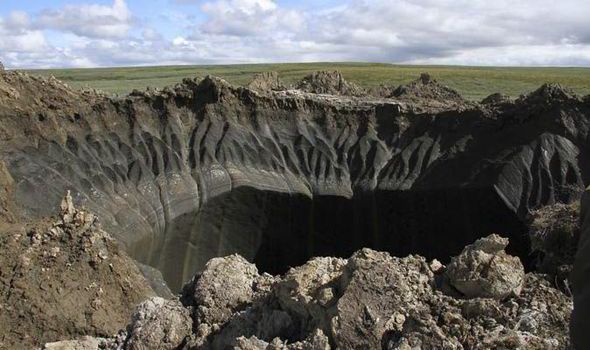
Mysterious craters are popping up in Russia, believed to be caused by methane gas eruptions in melting permafrost, scientists have said today.
The huge mushrooming of holes are a ticking time-bomb, according to one Russian expert, who says that a recent outbreak of craters just six miles from a major gas production plant could be a disaster waiting to happen.
Express.co.uk reports:

BYPASS THE CENSORS
Sign up to get unfiltered news delivered straight to your inbox.
You can unsubscribe any time. By subscribing you agree to our Terms of Use
Scientsts are still baffled by the exact processes causing the craters and respected Moscow expert Professor Vasily Bogoyavlensky today called for “urgent” investigation of the new phenomenon amid safety fears.
Until now, the existence of only three Siberian craters had been established.
“We know now of seven craters in the Arctic area,” he told The Siberian Times – referring to the larger holes.
“Five are directly on the Yamal peninsula, one in Yamal Autonomous district, and one is on the north of the Krasnoyarsk region, near the Taimyr peninsula.
“We have exact locations for only four of them.
“The other three were spotted by reindeer herders.
“But I am sure that there are more craters on Yamal, we just need to search for them.
“I would compare this with mushrooms.
“When you find one mushroom, be sure there are few more around. I suppose there could be 20 to 30 craters more.”
Two of the newly-discovered large craters – also known as funnels to scientists – have turned into lakes, revealed Professor Bogoyavlensky, deputy director of the Moscow-based Oil and Gas Research Institute, part of the Russian Academy of Sciences.
“It is important not to scare people, but this is a very serious problem.
“We must research this phenomenon urgently to prevent possible disasters. We cannot rule out new gas emissions in the Arctic and in some cases they can ignite.”
The first hole was spotted in 2013 by helicopter pilots 20 miles from a gas extraction plant at Bovanenkovo, on the Yamal Peninsula.
An examination of the area using satellite images, comparing landscapes in the past with the present day, has alerted Russian experts to the prospect that the phenomenon is more widespread than first thought.
Experts are particularly interested in a crater they name B2, which just six miles to the south of the gas field at Bovanenkovo.
Old satellite imagery shows no sign of craters at the site but there now exists a lake, 100 metres by 50 metres, surrounded by 20 smaller holes filled with water.
These mini-craters are just a metre or two in diameter.
And, following the discovery of a funnel at Antipayuta, on the Yamal Peninsula, nearby residents told scientists about seeing a flash of light, possibly as a result of gas exploding.
Professor Bogoyavlensky said: “We need to answer now the basic questions: what areas, and under what conditions, are the most dangerous?
“These questions are important for the safe operation of the northern cities and infrastructure of oil and gas complexes.”
There is already scientific concern that Lake Baikal, the largest and oldest freshwater lake in the world, but well outside the Arctic Circle, could be among the places sitting on a “time bomb” ready to explode.
Scientists have previously said there is growing evidence that rising temperatures is the main catalyst triggering the blasts. Any continued increase – as is predicted by meteorologists – could create the ideal conditions for more craters to be formed.
It is thought permafrost at the sites could have one million times more methane hydrates locked inside than ordinary gas. One expert estimated that the total explosive power of the craters has been the equivalent of about 11 tonnes of TNT.
There are also two tectonic fault lines across the Yamal Peninsula, with another possibility being that the blow-outs are caused by a deadly combination of heat leaving these rifts, a higher than normal air temperature, and the “fire ice” melting.
The professor revealed one picture of a Yamal lake showing signs of what he calls “degassing”.
“This haze that you see on the surface shows gas seeps from the bottom of the lake to the surface,” he said.
“We call this process ‘degassing’.”
He is not sure if this lake, too, was previously a crater “or if the lake formed from another process.
“More important is that the gases from within are actively seeping through this lake.”

